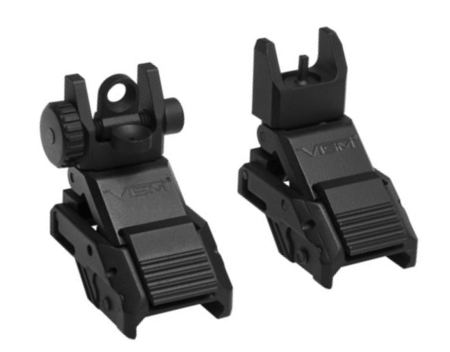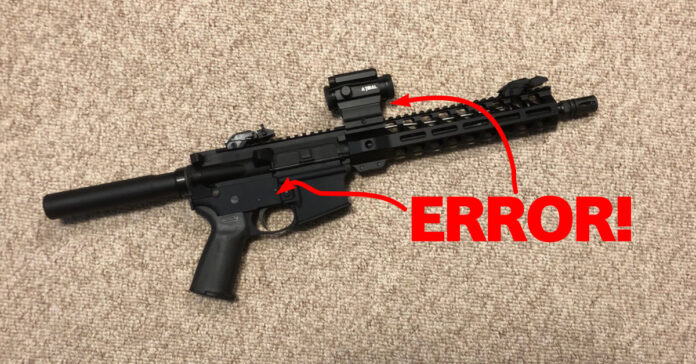I finally took advantage of the clear weather and gave the AR Pistol my son-in-law and I built over Thanksgiving weekend and thorough workout beyond the basic function check we did, and it was a good thing, too! The red dot optic I mounted shot 10 inches low and 4 inches to the right at 25 yards. That would be more than three feet off the target at 100 yards. Yikes!

The back-up iron sights I put on the gun were also shooting low. I cranked the front sight post down as far as I could, but it didn’t get me on the bullseye. Of course, these are a cheap set of Vism BUIS I had on hand in my big box of AR stuff. They are nowhere near as nice or sturdy as the A.R.M.S. sights I reviewed two years ago.
I spent so much time getting dialed in, evening fell before I could move the target out to 100 yards, so I do not know how close my zero is going to be at 100. I think that will be telling.
Other than that, the gun shot good groups, often with two-out-of-three shots touching.
Other Problems
During the testing, I ran across three other problems:
Bad Magazine
First, one of my old GI magazines, which I consider a range or practice magazine, would not consistently feed ammo into the chamber. I got dents in two of my cartridges as the bolt slammed into the side of the brass and caused a jam. I believe the spring has worn out and rounds were not being pushed upward with sufficient force. The gun and the ammo worked fine with other magazines. Given the age of this magazine, which I acquired used back in the mid-1990s either right before or during the Clinton gun ban, that’s not a shock. I’ve owned it for close to 30 years, and who knows how many years it saw in service before that. I’m not at all dissatisfied with that kind of performance from a product that was once considered little better than disposable.
Thankfully, I have lots of magazines. I slapped a piece of masking tape on the magazine, wrote “Weak spring” on it, and threw it in a box. If I am ever desperate for magazines, I can slide a new spring in there to recondition it. (I have new springs, followers and baseplates.) Until then, I’m going to stick with my Magpul Pmags.
Bad Trigger
The second problem is that the trigger was not consistently resetting. I was blaming the trigger, but it turns the trigger spring was installed incorrectly. I had to remove the pistol grip, which allowed me to remove the safety, so I could remove the trigger. Then I positioned the trigger spring correctly. It was a strange error. The gun would fire just fine. It only failed to reset and shoot a second time if you held the trigger back. This is why we didn’t catch the problem when we tested it the day we built it. We just made sure it went bang, and it did.
I made this repair this without reading up on it, looking online, or watching a video. I consider that a good sign because it means I could have fixed it after the SHTF. Of course, a better sign would have been getting it right the first time. Lesson learned. I don’t expect I’ll be making that mistake again.
Bad Eyes
The third problem is my old eyes. In 2015, I realized that my presbyopia (which is a technical term for old eyes that have trouble focusing up close) was making it harder to see the front sight on my rifles. My group sizes were at least 50 percent smaller when I used an optic. That’s when I started buying red dot sights for all my rifles.
Shooting today proved that when it comes to the front sight, my eyes have gotten worse. When I am wearing my reading glasses, that front sight on the AR is crisp and clear, a nice square block. When I take them off, it’s blurry. You’ve heard “aim small, miss small?” That’s no longer possible for me with iron sights and my natural, unaided vision.
I can shoot fine with a red dots because I can see the target and the red dot just floats in front of it. Magnified scopes also work well because they have a focus ring, so I can adjust the scope to match my eyesight.
While I had the targets set up at 25 yards, I ran a couple of magazines through my carry gun. That showed me it’s also getting more difficult to get a clear sight picture on a pistol. Not only is it tough to see the front sight without corrective lenses, but it’s difficult to line up the top of the front and rear sights. As a result, I sometimes end up shooting low. I can hit the center of mass at 15 yards, but a headshot would be more difficult. At 25 yards, my rounds were going low. As a result, I would hesitate to take any pistol shot at 50 yards. That’s limiting. It’s also frustrating!
Ramifications
Although I like optics, from a prepper perspective red dots have downsides compared to iron sights. For example, they need batteries. They are also more fragile. I bet iron sights would outlast optics in most environments. There may come a time when that is important.
Most of my red dot sights use a CR2032 coin battery, but one uses an AA, and another uses an AAA. I tend to stick spare batteries in the storage space of the gun’s Magpul pistol grips or buttstocks. I store extra batteries and I even have a small stash of rechargeable CR2032s. When I have a long gun with a mounted flashlight, I try to keep extra CR123 batteries on board as well.
This is also a reminder of how important reading glasses will be in a post-SHTF situation. I currently have a pair of expensive bifocals I keep at my desk, and I keep a pair of inexpensive readers in almost every other room of the house, plus a pair in the truck and another in my get home bag. I may get to the point where I have to wear one on a string around my neck like the old ladies who worked in the library during my youth. Ugh!
Also, I am seriously thinking of buying a new slide for one of my Glocks with an optic cut and mounting a compact red dot. That would become my carry gun and give me the ability and the confidence to make 50-yard shots again. Until then, I’ll just have to use a rifle, and AR pistol, or what may soon become a short-barreled rifle to make long shots.
Stay on Top of Your Equipment
I was happy to learn today that I had a bad mag, a bad trigger, and an off-center optic because I had all the time in the world to fix it. This is why you need to use your new gear, so you can identify and fix problems now rather than during a life or death situation.
Whenever you add new equipment to your survival stash, it’s important to test it out, eliminate any bugs, and ensure you are familiar with it. This applies to non-gun items as well. If you have a tent you’ve never used, set it up now so you will know how long it takes and if there are any tricks to it. If you plan to sleep in a hammock while you are bugging out, set up the hammock and try it out. Sleep in it for a couple of days. That will not only tell you if it is comfortable but if you need anything else, like a rain fly, a blanket, or more rope. If you plan to use a Coleman dual fuel stove to cook on, make sure you know how to pump it up and safely light it while you can still watch a video if you need to.
Things are getting dicey. This is a good time to make sure you and your preps are up to snuff.







